Theme and rheme

Theme and rheme are considered elsewhere on the site because the
concepts are applicable in a number of areas (genre-based
approaches, the use of the passive, academic writing, fronting,
markedness and much more).
There are links below to some of these guides.
This guide is concerned with investigating the idea a little more
thoroughly and is based on a functional linguistics approach, primarily the
work of Halliday (1994 and elsewhere) and subsequent authors.
Within that approach, language is a social semiotic
which means that it is the key way in which we human beings acquire
knowledge, express experience, attitudes and values and construct
our view of reality. Semiotics is the branch of linguistics
and philosophy which is concerned with signs and symbols and
language is, above all, a system of signs.
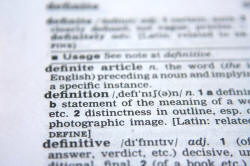 |
Definitions |
 |
Theme |
is defined by Halliday (1994: 38) as:
what the message is concerned with: the point of departure for what the speaker is going to say
For example in sentences such as:
- The man
told me where to go
The theme is The man because that is what the sentence is all about. - My house in
London is valuable but not for sale
The theme is My house in London.
We should not, however, confuse theme with subject, which is a grammatical rather than a communicative category, or agent, which is a different grammatical category present in passive expressions, because, for example:
- in a sentence such as:
Yesterday afternoon, we went to the park
The theme is Yesterday afternoon, because, in communicative terms, that is what the speaker is talking about. It is not, however, the grammatical subject but an adverbial noun phrase. The subject is we but that does not occur as the theme because it is actually part of the rheme. - in a sentence such as:
Spending time at the zoo is just what the children like best
The theme is Spending time at the zoo which is also the grammatical subject but formed by nominalising a non-finite verb phrase. - in a sentence such as:
Because it was raining, we stayed in and watched TV
The theme is Because it was raining and that is a clause in itself and not the subject of anything. It is, however, also a subordinate clause which cannot stand alone and make sense. - in a sentence such as:
The grass is kept short by the sheep
The theme is The grass which is a noun subject but not the agent (it is the patient in a passive sentence). - in a sentence such as:
The people who wanted a refund went to the manager's office
The theme is The people who wanted a refund because that relative clause structure is the starting point from which the rest of the utterance may be understood. - in a sentence such as:
Over that hill and across the bridge is where you need to go
The theme is Over that hill and across the bridge which is a combination of two prepositional phrases. In functional grammar, the prepositional phrases would usually be described as location Circumstances, by the way, but, in this case, Circumstances functioning as themes. - in a sentence such as:
The car has been repaired
The theme, rather obviously, is the car because that is what the rest of the clause is concerned with. It is not, however, the subject of the verb, it is, in grammatical terms, the patient (i.e., the entity on which the verb acts) and the agent (perhaps the workshop or the mechanic) is absent in this case because it is of no importance or already known to the hearer / reader and need not be made explicit.
 |
Markedness and themes |
There is a good deal more on the meaning of markedness later in this guide. For now we'll just consider it in relation to the communicative purpose of an utterance or written text.
It is true that in most simple declarative utterances the theme
and the subject are often the same thing but that is not always the
case and things can become more complex, as we shall see. So,
for example, in:
My mother did the work
on Tuesday
we have the theme (my mother) which also happens to be the
subject of the verb, do. That sentence is unmarked.
However, in:
The work was done on
Tuesday by my mother
the theme is the work which is grammatically still the
subject but functionally the patient in a passive clause. In
this case, the sentence is marked because the speaker / writer has
deliberately chosen to place the work
in theme position.
And in
On Tuesday,
my mother did the work
the theme is on Tuesday because it is raised to mark it for
emphasis.
The important point here is that when the theme and the subject are
the same, the word order, in English, is described as unmarked,
i.e., it carries no special communicative force.
This is only true for declarative sentences. In interrogative
sentences, the theme is the finite verb:
May
we come in?
and in imperative constructions, it is usually the Predicate because
the subject is generally absent:
(You) stop that!
When the subject is present, that becomes the theme:
You try!
It is also the case that the theme can be made up the whole of an adverbial, a noun phrase or a prepositional phrase including any modification.
All of these examples are of what is called, for obvious reasons, a topical theme and that may be defined as
the starting point from which experiences are
unfolded in a clause
(Butt et
al,
2001: 136)
Topical themes such as the ones identified here are also all simple themes because they consist of one element only, although that element may be quite complex grammatically as the examples reveal.
When a topical theme is the only theme in a clause, it is normally just called a theme. There are, however, two other types of theme that this guide will consider (eventually).
 |
Rheme |
The rheme may be defined as:
everything else that
follows in the sentence which consists of what the speaker states
about, or in regard to, the starting point of the utterance
(Brown and Yule, 1983: 126/127)
So, in all the examples above, the rheme is what follows the theme (all of it).
The term rheme is another communicative category, not a
grammatical one. The grammatical term with which it is
sometimes confused is predicate which is defined as
the part of the sentence which says something about the subject.
So, for example the underlined parts of these sentences are the
predicates:
Yesterday, Paul
went for a walk
Surprisingly, she
refused the job
because they tell us about the subject of the sentence.
However, seen communicatively, the rhemes of these sentences are:
Paul went for a walk
and
she refused the job
because raising the adverbial to the front of the sentence has
marked it as the theme and all that follows, including the subject
of the verb is the rheme.
In this case, we actually have a different sort of theme in the
second sentence, called an interpersonal rather than topical theme
(realised with the word
surprisingly) because it expresses how the speaker feels. More on that
later.
 |
How simple rhemes become simple themes |
If you have followed the guide to genre, this will be familiar ground.
Here's a short example text which we will use to show the way in which themes and rhemes contribute to a cohesive paragraph:
On Monday, I have to get to the office early because I need to prepare for a meeting. This will be with two of the firm's most important clients and they are very particular and demanding. So much so that all of us, including the CEO will be there. She doesn't often attend meetings of this sort.
In what follows, we'll look at the functions of the parts which are underlined to demonstrate the relationships.
- The first theme is the prepositional phrase (or locational Circumstance) On Monday because it the scene-setter for all that follows. It is the jumping off point for the rest of the text.
- Part of the first rheme is a meeting and that becomes the theme of the next sentence, replaced by a demonstrative pronoun, this.
- Part of the rheme which follows is two of the firm's most important clients which forms the theme of the next part of the compound sentence (following and), replaced by the pronoun they.
- Part of that rheme is the adjective phrase particular and demanding and that, replaced by a modified pro-form with so much so, forms the theme of the next sentence.
- Part of the rheme of that sentence is the CEO which forms the final theme of the last sentence, replaced by the pronoun, she.
It would be somewhat surprising if the text did not go on to say something more about the CEO because that has been set up as a cohesive link in the final theme.
It is not always as simple as this because rhemes can appear in a
sentence but not become themes in their own right until much later
in a text so, although rheme 1 may become theme 2, rheme 6 may have
to waits its turn until sentences 12 before it is elevated to the
status of a theme.
For example:
| Simple structure | More complex structure |
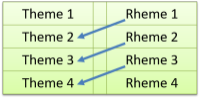 etc. |
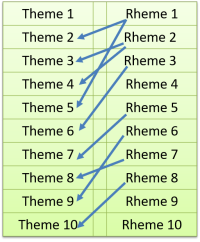 |
Thus, in more complex arrangements, rhemes (or parts of them) may
form later themes more than once and some rhemes may never become
themes at all. Others have to wait in line until their number
comes up.
The important thing to remember in terms of teaching coherent
writing and speaking is that all themes bar the first should be
formed from previous rhemes. Parachuting in a new theme
unrelated to what has come before just confuses the reader /
listener.
A way of presenting a very simple structure to learners is:
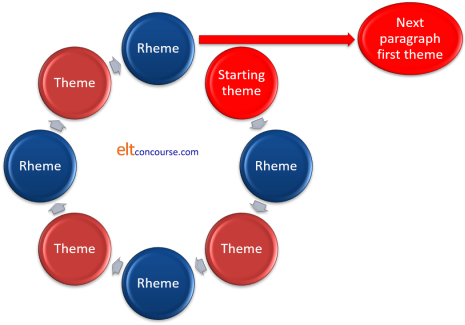
Even from an unrealistically simplified scheme like this,
low-level learners can be encouraged to produce simple texts in
which each theme has a rheme which forms the theme of the next
sentence and so on. The text may not be terribly sophisticated
but it will be coherent and, with a little training, cohesive too
because rhemes often contain noun or prepositional phrases which can
be substituted by various pro-forms.
So, for example, we can set up what is called a shell noun (because
it encapsulates one or more propositions) by having a sentence such
as:
The number of students who are using the kitchen and leaving a mess behind them as well as stealing from the fridge is becoming a serious problem.
and in that sentence we have used a shell noun (problem)
which encapsulates the whole of the first part of the sentence.
We have also made it the rheme.
Now, in what follows we can refer back to that shell noun with a
pro-form such as this or it or a synonym such as
issue and make the pro-form or the synonym the theme of
each sentence as in, e.g.:
This cannot be tolerated much longer or it
will result in ...
This issue has to be tackled by ...
In that way a simple noun can be used to set up a cohesive text
efficiently.
For more, try the guide to shell nouns on this site, linked below.
We should note here that, of course, we are dealing with the
relationship between the text and its context because that lies at
the heart of social semiotics. And text can, naturally, be
spoken as well as written.
In spoken texts, because of their nature, themes may come and go
quite rapidly and some rhemes may be discarded and never be elevated
to themes at all. Nevertheless, in any transcript of a
conversation, it is usually possible to spot the themes of each
participant's contribution and the rhemes that follow them as well
as seeing which rhemes are taken up as themes by subsequent
speakers.
| Speaker | Utterance | Theme | Rheme |
| Mary | John can't come to the meeting | John | can't come to the meeting |
| Pat | That's a shame. | that (can't come to the meeting) | is a shame |
| Mary | Yes, it is | it (a shame) | is |
| His mother's ill, I hear | his mother | is ill | |
| Pat | Serious, is it? | illness | is it |
| Mary | Apparently so | apparently | so |
In the final utterance in that dialogue we have an example of an interpersonal theme rather than a topical theme of which more in a moment.
 |
Three types of theme |
 |
Topical themes |
Most of the examples that were used to illustrate the definition of
theme were topical in the sense that the theme functions to set the
scene for what follows in the utterance.
We saw that topical themes can be:
- Nominal elements (nouns and pronouns which are usually
referred to as Participants), e.g.:
John and his mother went home
He made dinner - Complex nominalised non-finite clauses or noun phrases, e.g.:
My being ill so often has meant I can't work
The real reason for the breakdown in communication was lack of listening skills - Adverbials and prepositional phrases (Circumstances):
Secretly, she's quite pleased
In the event, I was surprised
On the following Thursday, we went again - Clauses:
After we had lunch, we went for a walk
So that he could identify the ship, he fetched his telescope
The key issue is that all these sorts of theme form the leftmost
constituent but that is not to say that they are necessarily the
subjects of any following verbs.
In some clauses, the topical theme can be preceded by another theme
and then we have a multiple theme. Themes that can precede the
topical theme are of two sorts, considered next.
 |
Ordering of clauses |
Alert readers will not have missed the fact that when subordinate
and main clauses are reversed, so are the associated themes and
rhemes. So, for example:
Because she wanted
to meet his mother, she travelled up to London
and
She travelled up to
London because she wanted to meet his mother
are not simply alternative ways of saying the same thing as the
themes (in black) show.
Theme and rheme are identified by word order and word order is not
selected at random.
Speakers and writers will select the word order to match what they
perceive as the theme of the sentence.
The first sentence would be followed naturally by something about
London such as:
While she was there, she took the opportunity
to visit the British Museum
and the second sentence would be more naturally followed by
something about the mother such as:
She was delighted to see her
If we follow the first sentence with something more appropriate
to the second we get:
Because she wanted to meet his mother she
travelled up to London. She was delighted to see her
in which we are left in a state of ambiguity regarding who was
delighted to see whom.
If we follow the second sentence with the theme appropriate to the
first, we get:
She travelled up to London because she wanted to meet his
mother. While she was there, she took the opportunity to visit
the British Museum
which is only marginally coherent.
The phenomenon of dative shifting (or dative alternation) is
another simple trick with which people can mark the rheme to allow
it naturally to form the theme of the following clause or sentence.
Here's an example:
He told his mother a lie ...
is naturally followed by:
which she saw through immediately
but
He told a lie to his mother ...
would more naturally be followed by:
... and she was upset about that.
In the first case, the lie becomes the theme of the
following clause and in the second case, it is the mother
which forms the theme.
See below for a discussion of how intonation affects the communication of information in such circumstances.
 |
Textual themes |
We saw that the theme-rheme structures with the latter becoming
the former are a prime mover of coherence in a text.
Textual themes are an element of cohesion rather than coherence.
Textual themes are frequently conjunctions or conjuncts (go
elsewhere for the technical difference
[new tab]). Here are some
examples:
When Mary arrived at the
hotel, she checked in and went directly to her room
Nevertheless, this is
important
But I couldn't see anything
I checked into the hotel.
There, I called my wife.
In spoken language, textual themes are often quite simple and often repeated so stretches of text may be held together with no more than a succession of ... and ... and ... so ... and ... etc.
The issue to note is that textual themes are followed in many
cases by topical themes, making a multiple theme. In the
examples above, the topical themes are Mary, this and I,
respectively, and they all follow the textual theme which is,
conventionally, left positioned in the clause.
It needn't be, of course because most conjuncts can take the medial or end
position in a clause so we could have, e.g.:
This is,
nevertheless, important
or
This is important,
nevertheless
and we still have a topical theme (this) and a textual
theme (nevertheless).
Some conjuncts are, in fact forbidden from the initial
position but that does not affect their function. For more see the guide (linked below).
Wh-words also function as textual themes and are less mobile, almost always
occurring on the extreme left of the clause as in, e.g.:
Where he found the
energy I don't know.
What is she doing?
When can you come?
etc.
You can often tell the nature of a text from the textual themes
it contains. For example:
A Narrative or Recount will often contain conjunctions and conjuncts which
link events in time such as and then, afterwards etc.
A Discussion text will more likely contain subordinating
conjunctions such as if, although, unless, because etc.
which serve to link ideas logically rather than in temporal
sequence. It may also contain conjuncts working in the same
way such as however, nevertheless, consequently and so on.
A Procedure text will often contain explicit enumerative conjuncts
such as firstly, lastly, next, after that etc.
An Exposition will also contain textual themes designed to show the
connection between ideas (such as because, it follows that, so
etc.) and may also contain enumerators which
serve to make distinct points in order and lend an air of
development of an argument. Expositions are also indicated by
the inclusion of rhetorical questions as textual themes setting up
an issue before offering a solution.
An Explanation or an Information report on the other hand, will
focus more on textual themes which link ideas additively and
include, for example, and, additionally, furthermore, in order
to, therefore, and so etc.
 |
Interpersonal themes |
These concern
the kind of
interaction between speakers or the positions which they are taking
(Butt et al, op cit.: 138)
A common example is the interrogative in English in which the
auxiliary verb precedes the subject or the operator do is
required to complete the utterance.
For example, in:
Can she go now?
we can analyse the theme as a multiple one, with an interpersonal
theme (Can), plus a topical theme (she).
and in
Perhaps they will arrive
we have an interpersonal theme expressing the speaker's attitude (Perhaps)
and a topical theme (they) forming a multiple theme.
The interesting point here is that English allows various
positions for interpersonal themes (which do not have to be
left positioned) so we allow:
They will perhaps arrive
She has, apparently, left already
They will be here, I think
and so on.
Interpersonal themes occur also in the imperative, e.g.:
John, be quiet
in which we have the interpersonal theme followed by the
topical theme
be.
 |
If you would like a short test to see if you have grasped the essentials so far, click here. |
 |
Markedness |
There is a separate guide to markedness on the site but, briefly,
if something is unmarked, it is the most unremarkable or normal way
of expressing something whereas a marked element is distinguished in
some way. Compare, for example:
The electorate don't like him
which is unmarked and simply the canonical ordering of Subject, Verb
and Object in English
with
Him the electorate don't like
which is marked to emphasise the object pronoun.
In the first case, the theme is the electorate and in the
second, it is him both conventionally left positioned as
themes usually are.
 |
Peter helped JaneIn English and all other natural languages, there are multiple ways of presenting the same information using different grammatical structures and ordering the constituents of the clause differently. For example, this simple sentence may be expressed (at least) 22 different ways in English as: |
| Jane was helped by Peter. Peter gave Jane some help. Jane was given some help by Peter. It was Peter who helped Jane. It was Jane whom Peter helped. It was Jane who was helped by Peter. It was Peter who gave Jane some help. Peter was the one who gave Jane some help. Jane was the one who was given some help by Peter. Peter was the one who helped Jane. Jane was the one whom Peter helped. |
Jane got some help from Peter. Jane was the one who got some help from Peter. It was Jane who got some help from Peter. It was Peter whom Jane got some help from. It was Peter from whom Jane got some help. Some help was given by Peter to Jane Some help was got by Jane from Peter. Peter it was who helped Jane. Jane it was whom Peter helped. Peter it was from whom Jane got some help. Jane it was who got some help from Peter. |
Why should this be? If all the examples above express the
same propositional content:
helping happened
Peter did the helping
Jane got the help
why does a language (any language) need so many possible syntactical
resources to express the same content?
One answer is that speakers need to make choices about what they
consider the jumping off point for the clause, Halliday's point
of departure, and it is this that determines how the syntax is
arranged.
Placing an element, other than the subject, in theme position (i.e.,
on the left
of the clause) often marks it in some way because it raises its
significance to a theme for the sentence. For example:
They ate the meal
is unmarked with the theme they
but
The meal was eaten
is marked because the theme is now the meal.
The speaker / writer's intention concerning markedness is often the
stimulus for the selection of a passive formulation.
This also happens with other elements, for example:
All over town I looked
which, by virtue of placing the prepositional phrase in theme
position, makes it heavily marked.
Only in emergency, switch this computer off
which heavily marks the contingent phrase.
 |
Left dislocation |
This is a phenomenon usually confined to literary works (hence
novel titles such as Cry, the Beloved Country [Alan Paton, 1948])
but which also occurs in informal speech. It concerns an item
appearing to take the theme position in a sentence but which is not,
in fact, intended as the theme.
For example,
A: Have you seen Pedro?
B: Pedro, I saw him upstairs
in which the theme of B's utterance is, in fact, not Pedro (that's
the rheme of A's utterance) but is I and the rheme of B's
statement is saw him upstairs. The first item in B's
statement may sound like a question and it stands alone to mean
something like
Did I hear you right?
Learners who speak a topicalising language such as Spanish or
most Chinese languages may produce utterances like this
unintentionally and that can confuse the hearer as to what is
intended as the theme.
 |
How themes and rhemes are linked: the nuts and bolts |
English links themes and rhemes in a number of ways. Here's a short list with some examples of how the linkage works:
- coordinating conjunctions
- John came to the party with some people
but
his sister wasn't one of them
in which John is the theme and came to the party with some people is the rheme which is referred to in the next clause with his sister (although she was not part of the group). - subordinating conjunctions
- The company has instituted a new policy
although the
scheme is very unpopular with most of the staff
in which the theme is the company with the rheme has instituted a new policy linked by the conjunction although to the next theme, the scheme (synonymous here with the policy). This is also an example of the use of synonymy to make things cohesive, see below for a simpler example. - correlative conjunctions
- The work was poorly done,
either hurried
or on the cheap
in which the theme is the work which has the theme was poorly done that becomes the next theme and is linked by either ... or. - relative pronoun clauses
- The parents eventually collected the children
who were
waiting in the rain
in which the theme is the parents with a theme eventually collected the children connected to the next clause by who. The pronoun who forms the next theme and its rheme is were waiting in the rain.
All relative pronouns (who, whom, which, that, whose) perform this function. - relative adverb clauses
- She went back to the village
where her parents were still
running the pub
in which the first theme, she, is followed by its rheme went back to the village and the village is made the theme of the next clause by the adverb where concerning her parents with its rheme were still running the pub. - conjuncts
- The train is late and
consequently I can't make the meeting on time
in which the theme is the train with its rheme is late linked to the next clause by the coordinating conjunction and but also with the conjunct consequently. - pro-forms
- The manager gave the meeting the figures.
That made
everyone sit up and take notice.
in which the manager is the theme, gave the meeting the figures is the rheme and that rheme becomes the next theme linked back by the pro-form that which stands for the rheme (the whole predicate) of the previous clause. - pronouns
- Pronouns constitute a significant sub-set of pro-forms and,
as the name implies, usually stand for noun phrases so for
example we can have:
John looked unhappily at his garden. It was a total mess.
in which the pronoun performs its usual task of standing for the garden and linking the two clauses, making the rheme of the first the theme of the second.
A range of pronouns can also stand for other types of phrase or clause as in, for example:
We eventually managed to move the cupboard. It was pretty hard work
in which the pronoun stands for the verb phrase (managed to move) and its object
I put the vase in front of the mirror. It was the best place
where the pronoun stands for a prepositional phrase
Peter and Fred sold their house. They hadn't lived there long so it surprised everyone
in which the pronoun there stands for the house and the pronoun it for the entire previous utterance.
Pronoun reference is normally the first way that learners acquire to link theme and rheme coherently (but they may not know they are doing that). - non-finite clauses
- The manager gave the meeting the figures.
Doing so made
everyone sit up and take notice
in which the structure is similar but the linkage is achieved by the non-finite verb phrase and pro-form, doing so. - finite clauses
- The man was walking along the muddy river bank, when
it gave way under him
and he fell.
in which the theme is the man, the rheme was walking along the muddy river bank and the linkage is achieved by the finite clause it gave way under him. The subordinating conjunction when plays a linking role. - hyponymy
- I was late because my train was.
The service is
getting worse
in which we have a hyponym, the service, functioning to include my train (part of the rheme of the first clause) making it the theme of the second clause. - synonymy
- The rock was enormous, so
huge that we couldn't shift it without a
tractor.
in which the synonyms enormous and huge serve to link the rheme of the first clause when it becomes the theme of the second.
All of these systems have their own guides linked from the syntax, lexis and discourse indexes.
 |
Other languages |
We should pause here to consider how some other languages achieve
markedness and how they don't. The first thing to state is
that it is word order alone in English which determines whether
something is the theme of a sentence. Reverse or manipulate
the word order and the theme-rheme structure is reversed or changed.
We saw this with the discussion of subordinating conjunctions above.
Other languages have freer or different word ordering conventions,
of course.
We saw above that, in English, raising an element of a clause to
the initial theme position marks it so we can have, for example
We ate well in that restaurant
in which the conventional topical theme, We, is where one would
expect to find it and the elements of the clause are unmarked for
any special consideration. However, we can also have:
In that restaurant we ate well
which raises the prepositional phrase adverbial to the theme and
marks it. We can also have, e.g.:
That restaurant is where we ate well
which raises that restaurant to the marked theme position.
We can also, and frequently do, mark the object of a verb as in, for
example:
Cigars are what she smoked
or
Cigars were smoked by her
and in both those cases the normal canonical word ordering
(Subject–Verb–Object) in English is disturbed for rhetorical effect.
(That, incidentally, is just one use of the passive in English.)
Other languages do things differently.
Tagalog (a language spoken as a first language by some 22 million
people and as a second language by three times as many), to take
just one example, typically
places the theme in the final position in the clause (Lock, 1996:
227, drawing on Martin 1992).
Even languages which are similar to English in terms of canonical
word ordering such as Italian and Spanish, will often place the
object of the verb in the initial position but that does not signal
markedness – it is simply a feature of the languages. So, for
example, in Italian it is common to find the object placed in what
in English would be a marked theme position but which carries no
particular emphasis. For example:
No, la lasagna l'ha consigliata Elizabeth
is literally
No, the lasagna it recommended Elizabeth
(Lock, 1996: 228, drawing on MacWhinney and Bates, 1984.)
Some languages, notably Chinese languages and Japanese, routinely place the topic (i.e., the
theme) in the initial position of the clause but, it bears
repeating, this does not carry any particularly significance in
terms of marking. They are known, in the trade, as absolute
themes, incidentally.
So, for example, in Japanese, we find:
Sakana wa tai ga ii
which is translatable as:
As for fish, red snappers are good
and in which the particle wa marks the theme and the
particle ga marks the subject of the verb.
Many Germanic languages also routinely place the time adverbial in
what would be in English a marked initial theme position but which
is not marked in those language, so, for example, in German we might
encounter:
Gestern bin ich nach Berlin gegangen
which is, word for word:
Yesterday am I to Berlin gone
but the initial position of the noun adverbial does not single it
out for particular attention as it would in English where placing
tomorrow in the initial theme position endows it with more
significance than it gets in the conventional final position.
Compare:
I went to Berlin yesterday
in which we have the topical theme, I, and the
conventional following rheme (part of which, Berlin, is
quite likely to be the theme of the next sentence) with:
Yesterday, I went to Berlin
in which we have a multiple theme: a textual theme (the locational
Circumstance, Yesterday) and a topical theme, I.
The act of inserting the textual theme raises the significance of
the Circumstance in a way that it would not in many other languages.
 |
Implications |
There are two obvious implications:
- Speakers of languages which differ from English in this respect may produce utterances in English in which an element appears, to a native-speaker ear, to be marked but is not intended that way.
- Speakers of such languages may not grasp the significance of left positioning of elements in theme position in English and may, therefore, misinterpret what they hear or read, missing the communicative effect of marking one of the constituents.
So, for example, in response to:
Can you do it next week?
we might have:
Next week I'm going on holiday
which, in English clearly sets Next week as the marked theme (and
implies No, I can't).
A speaker of a language which routinely places the time adverbial in
the leftmost part of the clause may well miss the special emphasis
that has been placed on the adverbial and assume that the holiday is
the important element when it is the timing which the speaker wishes
to mark by raising next week to the theme position.
Equally, a speaker of such a language may produce:
Next week I'm going on holiday
in the mistaken belief that it is equivalent to the English
I'm going on holiday next week
which it isn't, so a native-speaker listener may well spend a little
time trying to work out what is so important about next week.
These differences are unlikely to result in full communication breakdown but they may well disturb the expected theme-rheme progression and disorientate the reader / hearer.
 |
The given and the new |
The positioning, in English, of given and new information
parallels the organisation of theme and rheme insofar as the given
generally occurs in the theme and the new in the rheme.
For example, in
A: Where did John go?
B: He went to London to see his kids
The opening textual theme is Where and the rheme is
did John go.
The rheme of the first speaker's comment forms the given theme of
the response and the rheme of that response is the new information (went
to London to see his kids). The exchange might go on in
the same manner with each rheme taken up as the theme of the next
speaker's utterance, like this:
A: Are his kids with his ex-wife, then?
B: Yes, she always has them over the summer holidays.
and so on.
An allied conceptualisation is that English is strongly end focused
in that new information is conventionally placed towards the end of
an utterance but that has, arguably, less explanatory force than
analysing conversational, and written, information ordering as the
workings of theme and rheme.
For more on end focus, see the guide to extrapositioning linked in the list of related guides at the end.
 |
Intonation |
Intonation concerns tone units, the centres of which are called
the nuclei. The nucleus of a tone unit is the region in which
there is the greatest prominence. For example, in the usual
pronunciation of:
She's going to London
we would expect the pitch to rise on the first syllable of
London and then fall (the usual way). So the contour
looks like:

Because of what we know about theme and rheme structures, we can
easily identify that the next sentence will concern London,
not she. Hence the intonational focus on the new
information conventionally encoded in the last content word of the
clause. Note that it is the last content word, not the last
word because in:
She's going to cut the tree down
we would still expect the nucleus of the tone unit to fall on
tree not down, so the contour is:
![]()
What intonation does in English is signal the onset of the new
information in a sentence and, as that information is usually
encoded at the end of the rheme, in preparation for its becoming the
theme of a new sentence, that is where the most prominent pitch
movement will occur.
So, to take our two examples above where we discussed
subordination, we will get the following contours:

and you can see that the contours are parallel but, most
importantly, the information on which the nucleus of the tone unit
falls is different and so is the communicative effect.
 |
Teaching implications |
We have seen so far that:
- Themes in cohesive texts, whether written or spoken, are
conventionally formed from elements of the preceding rhemes.
Introducing unassociated themes generally results in incohesive or incoherent speaking and writing. - Textual themes serve to add a layer of cohesiveness in addition to the coherence offered by logical theme-rheme relationships.
- Placing any element other than the subject in theme position, in English, marks it as remarkable in some way, especially if its normal or canonical ordering is not to appear in the leftmost position.
- Topical and textual and interpersonal themes may be combined to make multiple themes.
Knowledge of these four phenomena can contribute very positively to helping learners of English construct and comprehend texts.
In particular:
- It is sometimes hard to pinpoint exactly what has gone wrong
in learners' production (whether written or spoken) although it
is clear that what they are saying or writing is obviously
faulty but the grammar and lexical choice are good.
The answer often lies in looking at how they are linking theme and rheme and what they are placing in the theme position based on the structures of their first languages. - Textual themes need attention in the classroom because they will vary significantly depending on the generic nature of the target text type. This means making sure that learners have, for example, mastered textual themes associated with consequences and logical connections before asking them to talk about or write about topics which demand them.
- At first, the focus of almost all teaching is on the unmarked forms of the language, so that the canonical or normal ordering of elements is acquired. Sooner or later, however, all learners will need to know how to depart from the learned ordering to mark some elements as more important than others. How this is done varies greatly from language to language and has explicitly to be the focus of the teaching.
- Stating, or allowing your learners to believe that there is
no communicative difference between:
If you like, I'll give you a lift
and
I'll give you a lift if you like
or between:
John broke the window
and
The window was broken by John
or between:
I stayed late because I had so much to do
and
Because I had so much to do I stayed late
has three avoidable and serious consequences:- It denies the learners the opportunity to see how theme-rheme organisation affects markedness and communication
- It is false information which will not help the learners
- It will result in false intonation patterns across the sentences
- Understanding that fluent and skilful writers and speakers will produce texts which are linked by thematic connections allows comprehension to proceed because the reader / hearer will be alert to the theme-rheme connections in a well-formed text.
 |
Taking a genre approach to teaching |
One approach to helping learners to recognise and produce cohesive and coherent writing and speaking is to take a genre approach to skills work. This normally follows this kind of pattern:
 To explain how this series of lessons might happen, we are going
to use a Discussion text that might, for example, serve as a short
spoken (or written) presentation. Choose carefully because
much depends on this text. It has to be representative of the
sort of text that you want your learners to be able to produce
independently by the end of the series of lessons. It also
needs to be quite easily comprehended because you are using the text
as a model for production, not mining it for new language.
To explain how this series of lessons might happen, we are going
to use a Discussion text that might, for example, serve as a short
spoken (or written) presentation. Choose carefully because
much depends on this text. It has to be representative of the
sort of text that you want your learners to be able to produce
independently by the end of the series of lessons. It also
needs to be quite easily comprehended because you are using the text
as a model for production, not mining it for new language.
For this example, this is the text:
I like the village where I live but I
recognise that living here has both advantages and disadvantages.
On the negative side, the place is quite remote and there are not
many of the services that people who live in larger towns naturally
expect. For example, there is no post office or bank and only one
small minimarket. There is also no doctor or dentist. This means
that we have to travel 10 kilometres to the local larger town to do
our banking and most of our shopping, post letters and access
healthcare. That's inconvenient and expensive.
Another disadvantage of living in a village is that it is quite
boring for my children because there is very little to entertain
them. There's no sports field at all and neither of the cafés is
really very interesting for them (although the older people meet up
to gossip and chat in them). Consequently, most of the kids in the
village take a bus to town in the evenings or at the weekend to meet
their friends and drink coffee with them. That all costs money.
Transport, too, is a problem because the local bus service is not
very good and there are no trains. The bus only goes to and from
town twice a day and the last bus at night is gone by 9 in the
evening. This means that we often have to act as a taxi service for
my children, taking them into town and bringing them home.
On the positive side, village life is very relaxing. There’s almost
no noise, especially after dark and getting to sleep is not a
problem. It’s waking my children up that is the most difficult part!
They have to catch the early school bus and they hate early
mornings. Because the village is quite small, there are no parking
problems. I just leave my car outside my front door and that’s not
something you can do in most towns.
The village is very friendly, too. There is a real sense of
community because everyone knows everyone and looks out for them.
People meet outside their houses or in the café and sometimes they
just walk in for a chat and a cup of something. There’s always
something to talk about.
Living here is cheaper, too, because house prices are lower than in
towns and most of our neighbours grow their own vegetables and keep
chickens. Free vegetables and eggs are always welcome. There also
isn’t so much temptation to spend money!
Finally, although transport is not good, we can be in the
countryside in a 5-minute walk from our front door. All our family
enjoy that and in the winter, we go skiing almost every weekend. In
the summer, having lazy picnics is what we like most.
All in all, I wouldn’t change where I live. I think there are more
advantages than disadvantages to living here.
- Analysis of the text

The assumption here is that comprehending the text will not be a time-consuming process and that the learners have the language resources to understand it quite easily. Nevertheless, you may have to spend a little time with some well-chosen comprehension questions making sure everyone is comfortable with the lexis and grammar.
Once you and the learners are happy, you can start the analysis.- Staging and structure
This is a discussion and it follows quite a simple set of stages. Here, you could get learners to identify each of the following sections:
Statement of the issue
Arguments against
Arguments for
Coda and personal statement of preference
This is not too challenging but it may be worth pointing out that we could reverse the ordering of the arguments or entwine disadvantages and advantages in separate paragraphs. - Topic sentences
Each paragraph in the text begins with a topic sentence setting the overall theme for what follows. The one for the second paragraph is
On the negative side, the place is quite remote and there are not many of the services that people who live in larger towns naturally expect
which contains a multiple theme:- A textual theme: On the negative side
- A topical theme: the place
- Types of themes
We saw that this topic sentence contains two themes and it is worth spending a little time identifying them although there is little need to use the meta-language of topical and textual themes.
It is enough if the learners can identify that the first signals the type of discussion which follows (a minus point) and the second signals the subject (communicatively and sometimes grammatically) of what follows. - Theme-rheme structure
This is a crucial stage so it needs to be taken carefully with plenty of time allowed for thorough analysis.
One way to do this is to exemplify what is meant by taking one paragraph and presenting it like this:
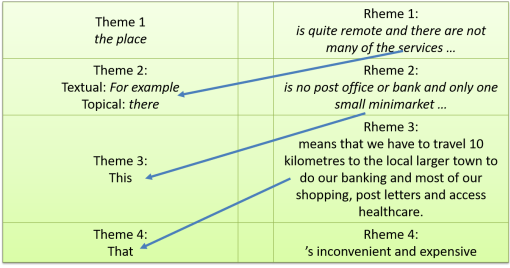
and then giving the learners blank grids to complete for the other paragraphs. This is an obvious vehicle for some pair-work cooperation. - Textual themes
Because this is a Discussion text, focusing on both sides of an issue, the important textual themes to look for are those which present contrasts, examples, alternatives, additions and consequences. Providing some examples and eliciting or explaining their functions is the place to start before asking the learners to locate the others. For example:
Paragraph 1: but
Paragraph 2: and, also, On the negative side, This means, For example
Paragraph 3: because, although, Consequently
and so on.
A little work distinguishing between conjunctions and conjuncts would be helpful here if the learners are capable of it.
Some work categorising the devices in terms of whether they introduce example, consequence or contrast is also needed.
Sequencers, too, can form a separate category.
- Staging and structure
- Controlled practice
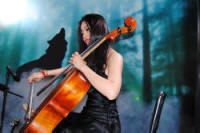
There are many ways to do this and much will depend on the text and text type on which you are focused. A few ideas are:- Writing themes and passing them on to a classmate to write the rheme.
For example:
The school is next to the station ...
... which is easy to find - Speaking a theme and getting a classmate to provide a relevant rheme.
For example:
I've just had a call from my brother
Oh, what did he say? - Selecting an appropriate theme from a choice of three which
matches a given rheme (or vice versa). For
example:
Which is the logical next sentence? A, B or C?- First clause: She and her mother have taken the early train to London ...
- A: ... because they need to be there before 9
- B: ... and they like travelling together
- C: ... and her mother will go shopping
- Skeleton or gapped sentences to expand by inserting textual
themes and
other elements. For example:
Put these words in the right places: consequently, surprisingly, so
__________ she gave up her holiday willingly. __________ the work was managed in time __________ the boss gave her an extra week off in the autumn. - Reordering paragraphs or sentences so they are coherent as well as cohesive.
- Matching points to examples by, for example, removing the examples in our model text above and getting the learners to put them in the right places depending on the topic sentences of each paragraph.
- Finding synonyms
of rheme elements which form the themes of following
statement such as
problem-issue
inconvenience-difficulty
advantage-plus point
printer-machine
hobby-pastime
etc. - Finding hypernyms (superordinates) and associated hyponyms
such as:
car-vehicle
means of transport-train
place-town hall
walk-saunter
etc. - Tracing lexical cohesion by lexical sets and fields.
The model text has, for example:
services: bank, post office, minimarket, doctor, dentist etc.
positive adjectives: relaxing, quiet, friendly etc.
activities: skiing, chatting, meeting up, acting as a taxi service etc. - Starting with simple sentences and adding adverbials to make
them more information rich. For example, expanding:
We went to London
into:
Last Tuesday we, my whole family and I, went by train to London in the morning - Combining simple sentences to make compound, complex and
compound-complex sentences. For example, combining:
We saw the hotel.
My sister got married in the hotel
to make:
We saw the hotel where my sister got married
- Writing themes and passing them on to a classmate to write the rheme.
For example:
- Guided writing

Here is where the real productive process begins. Much will depend on the abilities of the learners but you might try getting the learners to write a list of the advantages and disadvantages of, e.g.:
Their home town / city / village
The school or institution where you are set
A place they know well
The weather where they live
Schools
Air travel
etc.
Then the learners take each idea in turn and construct a short paragraph including:
A topic sentence
An expansion of the point
Two examples
One consequence
This is where you have to be quite active because the learners will need a good deal of support and help.
The learners then re-write and polish the paragraphs until they (and you) are happy. -
Free writing practice

At this stage, you can get away from a purely product approach (which is what we have, more or less, been following up to now) and implement a more process-focused procedure in which the learners brainstorm ideas, order them, draft the paragraphs, polish them, insert better exemplification, check their topical and textual themes and finally produce a version which satisfies them.
Finally, the learners exchange texts or conduct short oral presentations based on them for the rest of the class.
After a series of lessons like this (about 8 hours' work depending on the learners' abilities) you are ready to take a different genre, such as Narratives, Procedures or Information reports and repeat the process.
 |
Theme, rheme and speaking skills |
Up to now we have focused on written texts but the concepts of
theme and rheme are also important in the practice of speaking
skills because the ability to identify a speaker's topical and
textual themes but especially any interpersonal themes is key to
understanding intentions. The ability to signal such meanings
is also, of course, an aid to being correctly understood.
A beginning can be simply awareness raising of what the speaker is
signalling in something like this:
| Fill the gaps | |||
| What is said | What is the topic? | What is the connection? | How does the speaker want to be understood? |
| So, John's going to be late, I think | John | so (an unknown reason) | She is not 100% sure |
| Then we'll have to start without him | we | she is sure | |
| But his ideas are obviously important | |||
| I know but we must get on with this | |||
Once learners are alerted to the nature of the three types of theme in these little examples (and it is not too difficult to make up or find lots more of the same kind) some practice can be done with role plays in which the participants are told:
- what their topic is
- how they feel
- what they are connecting together
For example:
| Speaker A: You are late for an
important meeting. Apologise and say why you are late,
and how sorry you are. Speaker B: This is your meeting. Accept the apology but ask for more information about the reason and make it clear that you only believe some of the excuse. |
Carefully controlled but also semi-free exercises like this are, again, not too difficult to invent providing one bears the three sorts of themes in mind.
| Related guides | |
| genre in the classroom | for a simple guide to applying genre theory in practice |
| genre | for a less detailed overview of genre types |
| paragraph structure | for a guide which considers the conventional structuring of paragraphs in English |
| shell nouns | for the guide to how these can work together with theme-rheme structures to establish cohesion |
| genre in English for Academic Purposes | this has more detail but is linked primarily to EAP |
| markedness | if you would like to learn more about how English singles out items for particular emphasis |
| the word order map | for links to guides which consider some of these issues from a different perspective or two |
| extrapositioning and postponement | for more about end weight and end focus |
| spoken discourse | a general guide to speaking which draws on discourse analysis but also considers the structure of interactions |
| verbal processes | the guide concerned with what verbs do and what text types they appear in |
| writing skills | the first of two guides in the General English section |
| conjuncts | if the distinction between conjunctions and conjuncts is obscure with some discussion of their positioning |
References:
Brown, G and Yule G, 1983, Discourse Analysis, Cambridge: Cambridge
University Press
Butt, D, Fahey, R, Feez, S, Spinks, S and Yallop, C, 2001, Using Functional
Grammar: an explorer's guide, Sydney: NCELTR
Halliday, MAK, 1994, An introduction to
functional grammar: 2nd edition, London: Edward Arnold
Lock, G, 1996, Functional English Grammar, Cambridge:
Cambridge University Press
